Technologies
Is TikTok Safe for Kids? Change These 11 Privacy Settings Right Now
TikTok can be a dangerous place, especially for teenagers. Here’s how you can help protect them.
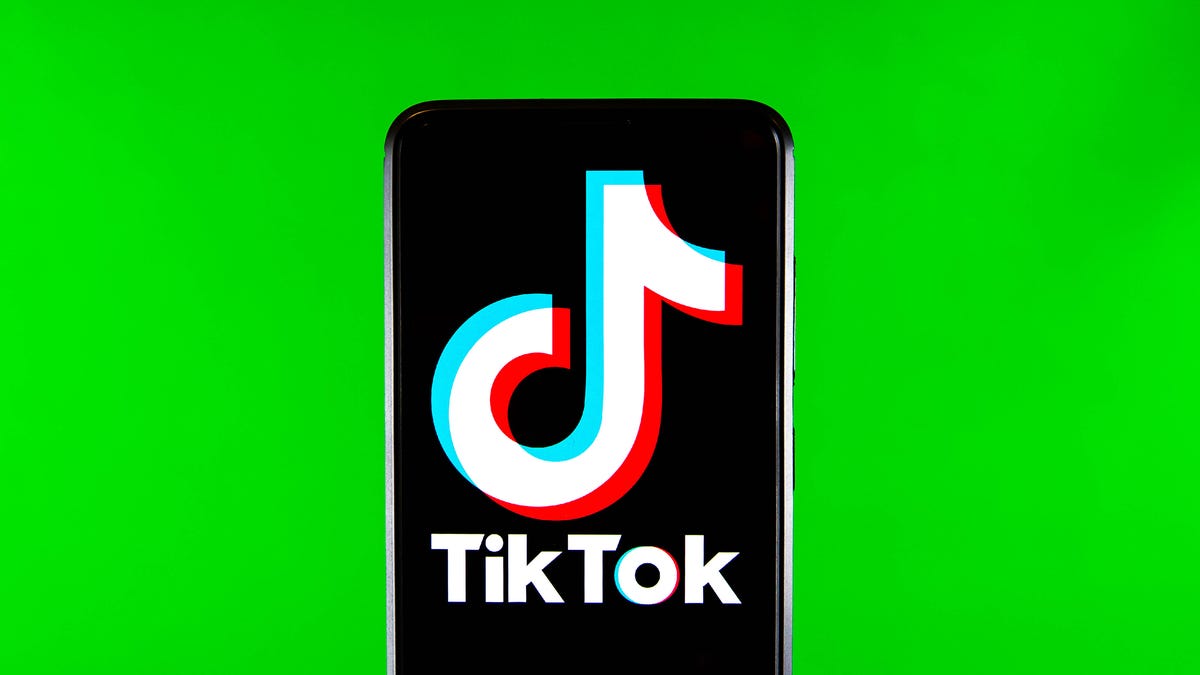
TikTok is the second-most-popular social media site among teenagers in the US. It not only offers kids an endless stream of entertaining videos, TikTok also connects people with their friends and family and with people who have similar interests. And it gives folks the chance to go viral with one of their own creations. But there’s also a dark side of TikTok.
Many kids and teens who have their videos go viral are subjected to harassment, ridicule and bullying. There’s also the worry of violent and obscene videos coming up in their timelines. Not to mention anonymous users sending inappropriate messages.
If you have kids on TikTok, or even use the service yourself, it’s important to become familiar with the features and settings TikTok offers to keep you safer while you’re online. Here are 11 settings that can help protect you from unwanted followers, harmful comments and violent videos on TikTok.
See everyone who views your TikTok profile
If you have a public account and you’re over 16 years old, anyone on TikTok can access your profile and watch your videos. (Accounts for people under 16 are automatically set to private.)
For many users, widespread exposure is the attraction of TikTok. It’s a chance for your content to be seen around the world. But you may not want everyone, like bullies or even some family members, to be able to view your TikTok account.
Luckily, it’s easy to find everyone who has looked at your profile.
- On TikTok, go to Profile and tap on the three-dash menu in the top right.
- Tap Settings and privacy and go into Privacy.
- Hit Profile views and toggle on Profile view history.
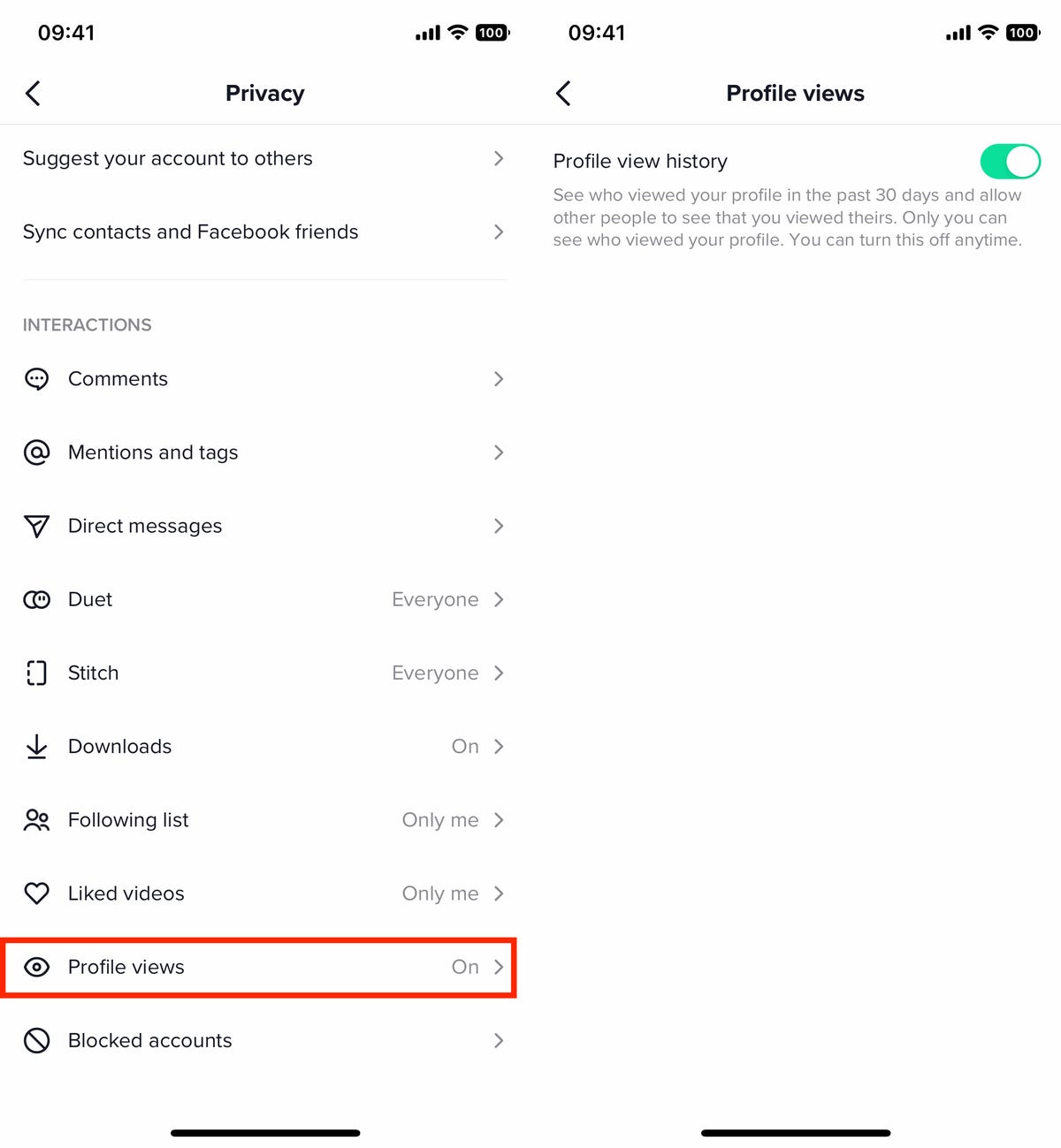

If you enable the profile views setting on TikTok, other people will be able to see when you check out their profile.
Nelson Aguilar/CNETYou’ll now be able to see everyone who’s viewed your profile in the last 30 days. If you find someone that you don’t want to have access to your profile and videos, you can then block them.
Block accounts on TikTok so they can’t see your profile
If you want to stop a certain account from being able to see your profile, you can block them — whether they’re harassing or stalking you, or for any reason you like.
- First, find the account you want to block and go to their profile.
- Next, tap on the three-dot icon in the top right.
- Finally, hit the Block button in the small menu that appears and then hit Block again when prompted.
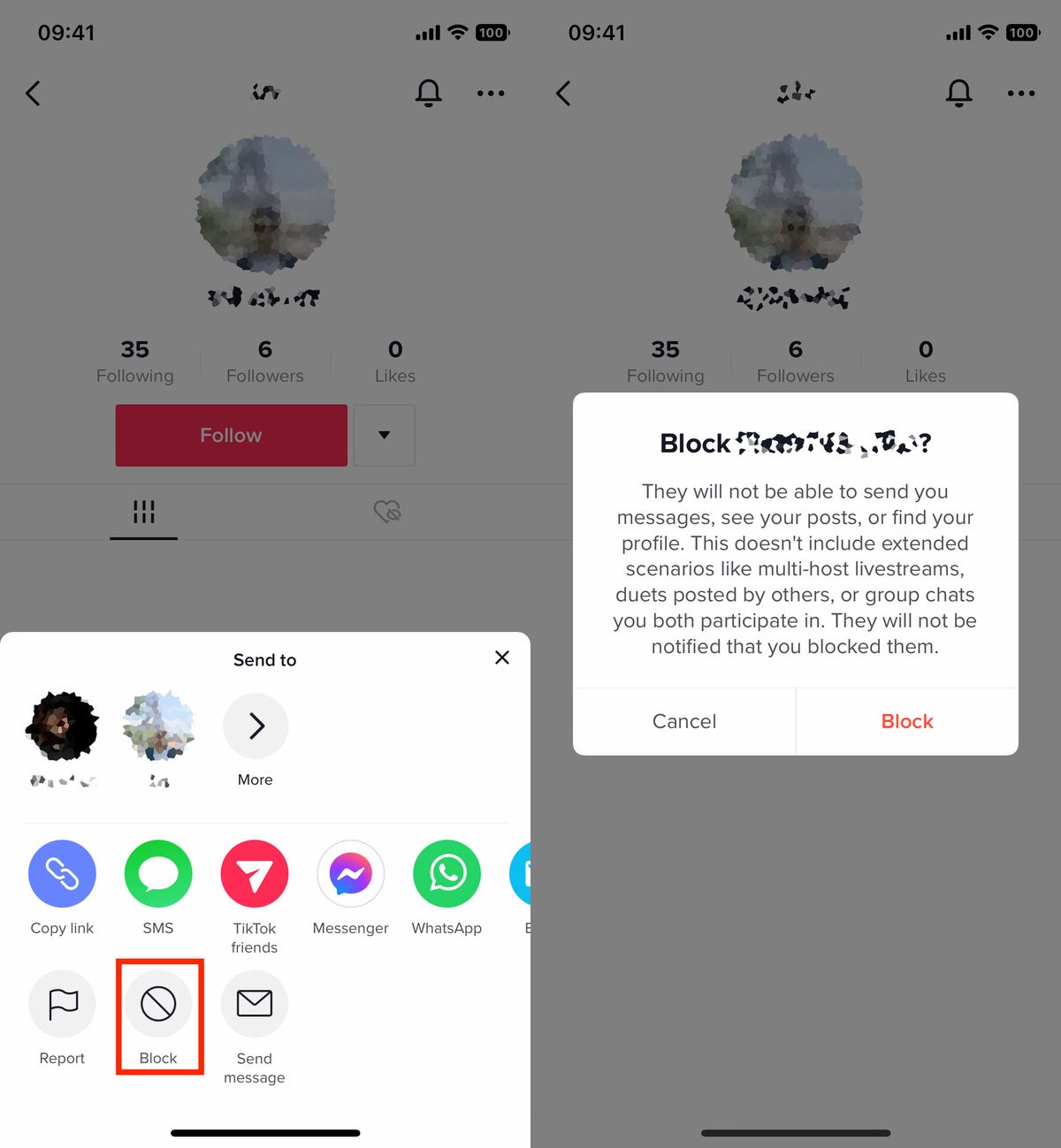

Block someone’s account so they can’t see your profile, send you messages and more.
Nelson Aguilar/CNETNot only will a blocked account be unable to view your profile, they also can’t send you messages or even find your profile by searching for it. However, if your video is in a duet or you’re on a livestream with multiple hosts, it’s possible that a blocked account may be able to see those videos.
Set your TikTok account to private to control who can see it
The easiest way to maintain your privacy on TikTok is to make your account private, meaning only people you actively allow can view your profile and videos. To make your account private:
- Go to Profile in the nav bar at the bottom of the page.
- Tap the three-dash menu in the top right.
- Hit Settings and privacy > Privacy
- Toggle Private account to On
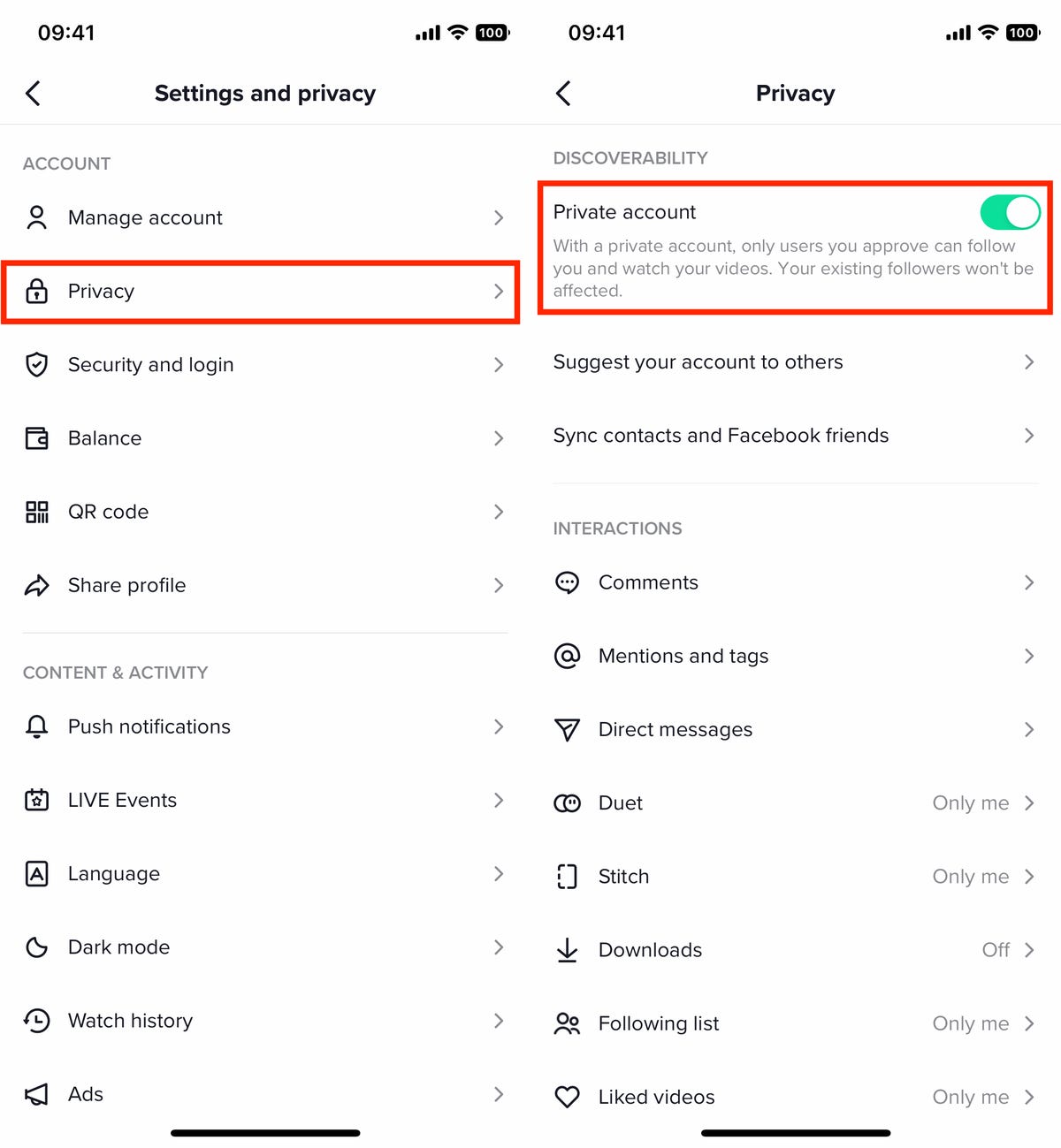

If your TikTok account is private, only those you accept as friends will be able to see your videos.
Nelson Aguilar/CNETAfter changing to a private account, only users that you approve can follow your account and watch your videos, but existing followers are allowed to continue following you. If that’s a problem, you’ll need to individually block any followers that you don’t want seeing your videos.
Stop people from downloading your TikTok videos
By default, anyone who stumbles across your video on TikTok can download it using the site’s built-in video download feature. If you don’t feel comfortable with other people having your videos saved on their devices, you can disable that feature.
- Go to Profile > three-dash menu > Settings and privacy
- Tap Downloads underneath the Interactions heading
- Toggle Video downloads to Off
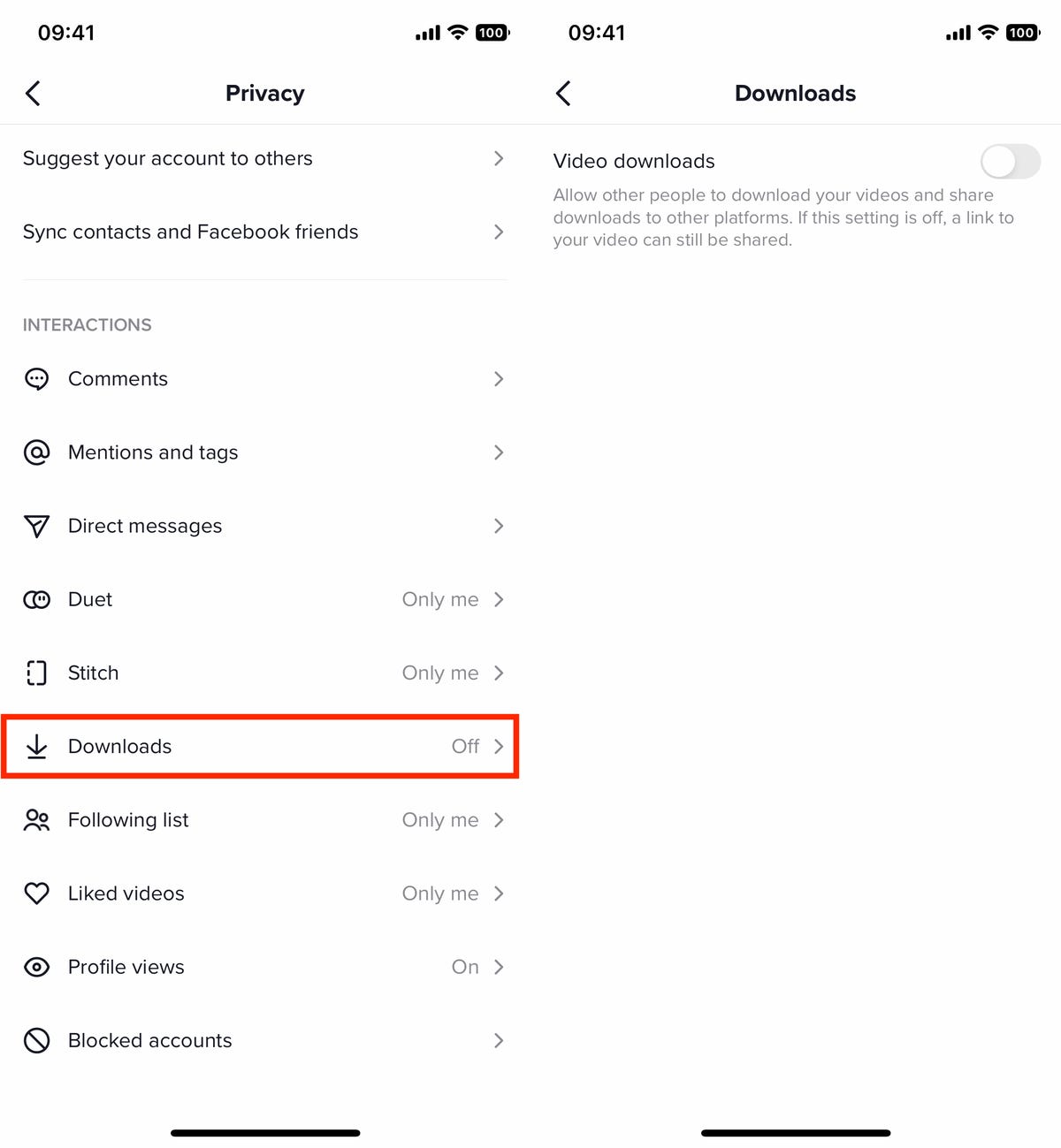

There are still other ways to download videos from TikTok, especially with third-party services.
Nelson Aguilar/CNETUnfortunately, there are other ways that people can download your videos, such as screen recording, third-party apps and shortcuts, but this setting will prevent one of the most popular (and easiest) ways of downloading videos from TikTok.
Report problematic accounts, videos or comments on TikTok
Blocking an account may not always be enough. If an account is pretending to be someone else or harassing people in general, you might be able to report the offending actions and have the account restricted or permanently banned. Not only can you report individual accounts, but also specific videos, comments and direct messages.
To report hateful, violent or other prohibited content on TikTok:
- Account: Go to the account profile of the offending party, tap the three-dot icon in the top right, hit Report and follow the instructions.
- Video: Long press on the video, tap Report and follow the instructions.
- Live: Long press on the live video, tap Report and follow the instructions.
- Comment: Long press on the comment, tap Report and follow the instructions.
- Direct Message: Long press on the message or messages, tap Report and follow the instructions.
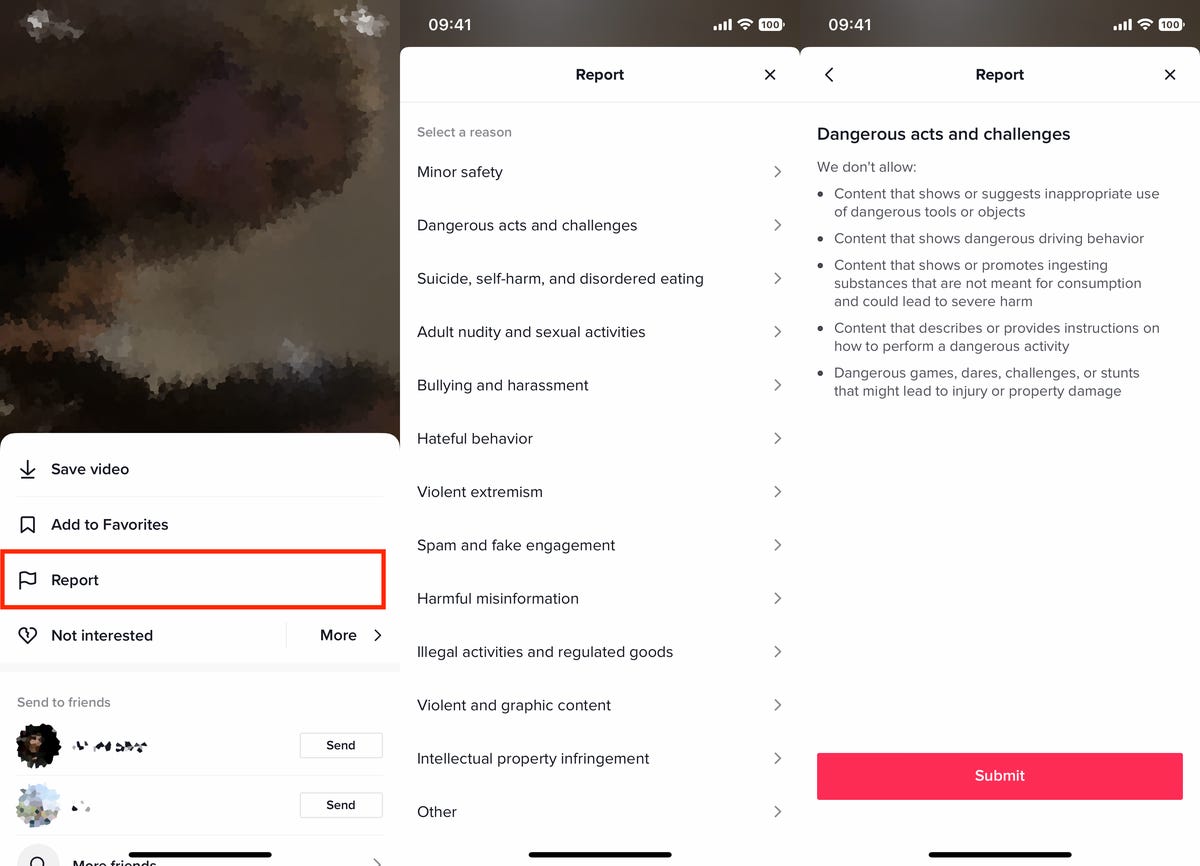

You can report TikTok accounts, videos, comments and other improper behavior.
Nelson Aguilar/CNETYou can report something for a variety of reasons, including minor safety, disordered eating, self-harm, adult nudity, bullying, harassment, spam, harmful misinformation, illegal activities, violent content and more.
Stop TikTok from recommending your account to other people
If you want your account to stay low-key and away from too many people’s eyes, you can stop your account from being suggested to other people that might have your contact information on their phone or have mutual friends with you. To stop your account from being recommended by TikTok:
- Go to Profile > three-dash menu > Settings and privacy > Privacy
- Tap Suggest your account to others
- Toggle off all the options
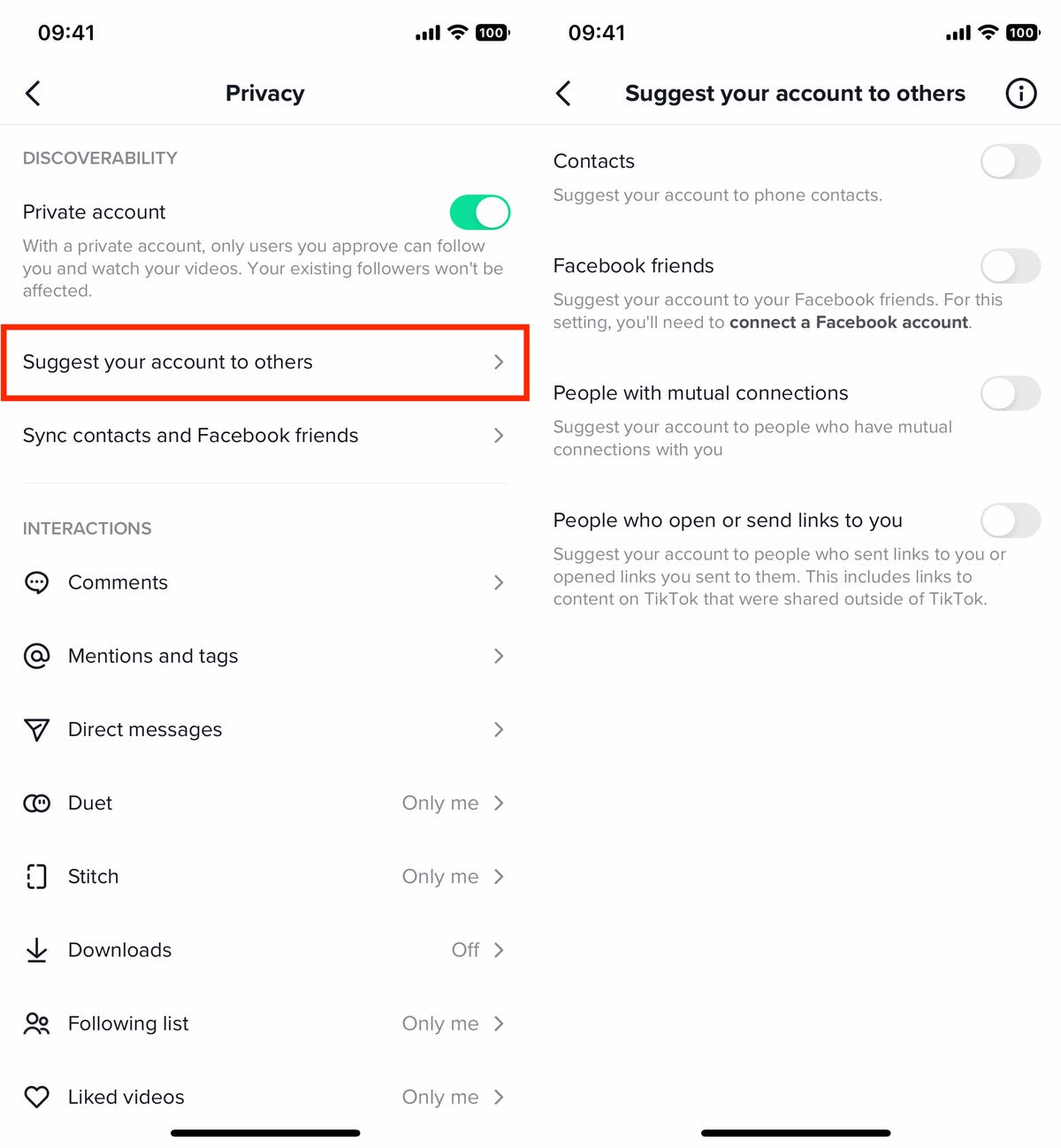

By default, your account is suggested to other people on TikTok.
Nelson Aguilar/CNETYour TikTok account is normally suggested to several groups, including your contacts, Facebook friends, people with mutual connections and people who open or send links to you (including links to content on TikTok that are shared outside of TikTok). Disable all of the settings to stop your account from being suggested at all, which will make it harder to find.
Keep your TikTok comment section safe and healthy
Comments on any social media service can quickly turn hostile, and TikTok is no exception. Fortunately there are several features buried in your TikTok settings to help you moderate your comments and eliminate spam and hateful comments.
To find your comment settings, go to Profile > three-dash menu > Settings and privacy > Privacy > Comments. Consider adjusting the following settings:
- Who can comment on your videos and Stories: Choose between all of your Followers, Followers that you also follow or No one.
- Comment filters: You can choose to filter all comments, only spam and offensive comments or comments with certain keywords. All filtered comments will be hidden until you individually approve them.
- Comment management: Here is where you can review your filtered comments, choosing Approve or Delete to decide which comments will appear beneath your videos.
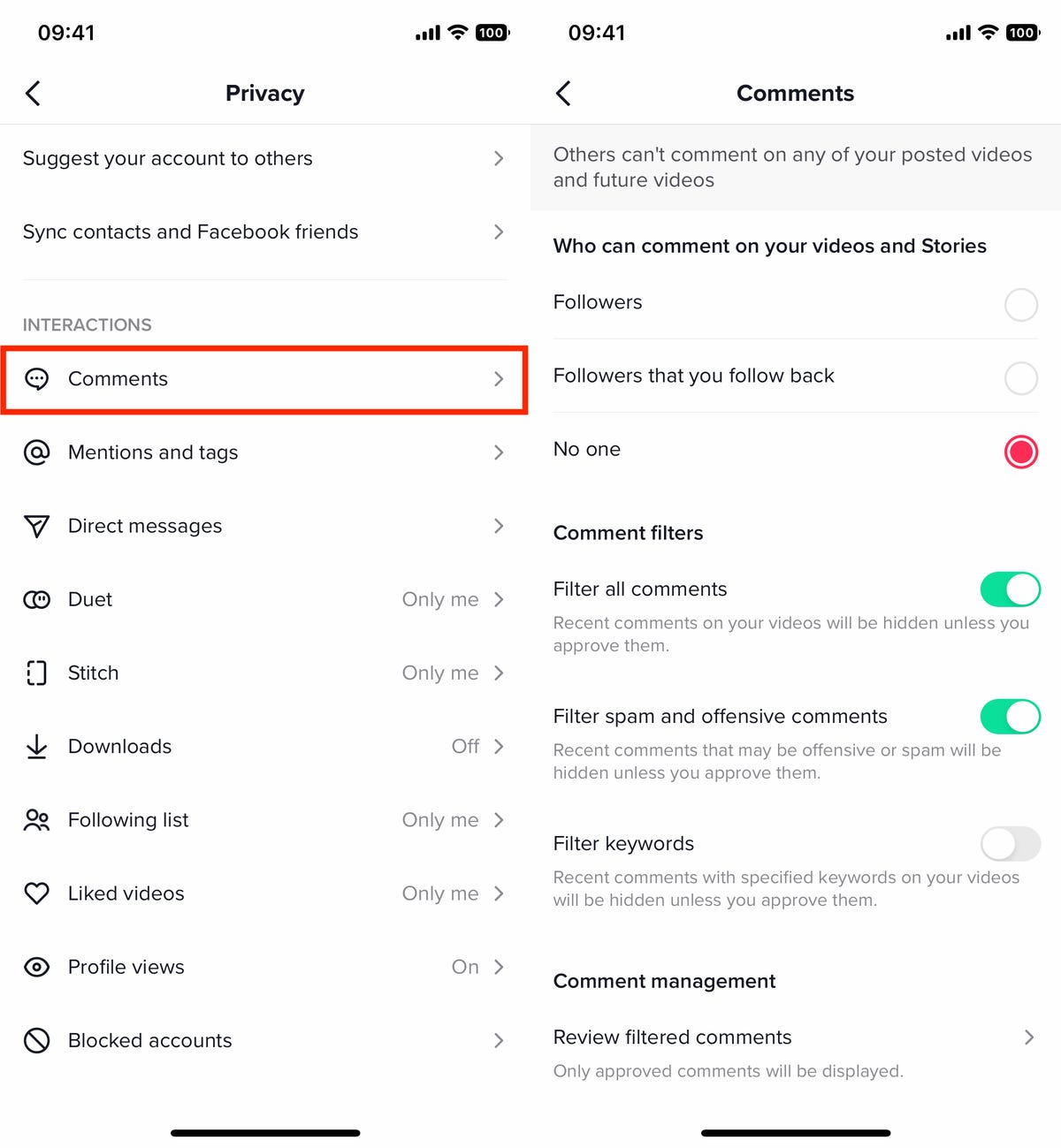

Don’t like what’s going on in your comment section? Use these settings to manage it.
Nelson Aguilar/CNETRestrict who can tag and mention you on TikTok
As long as someone knows your TikTok username, they can tag you in other videos or mention you in comments. If someone is tagging you in videos you don’t want to see or mentioning you in comments as a way of targeted harassment, there is a way to prevent unwanted tagging.
First, you’ll need to find the mentions and tags settings. Go to Profile > three-dash menu > Settings and privacy > Privacy > Mentions and tags, and configure these settings:
- Who can tag you: Choose between Everyone, People you follow, People that follow you back or No one.
- Who can mention you: Again, choose between Everyone, People you follow, People that follow you back or No one.
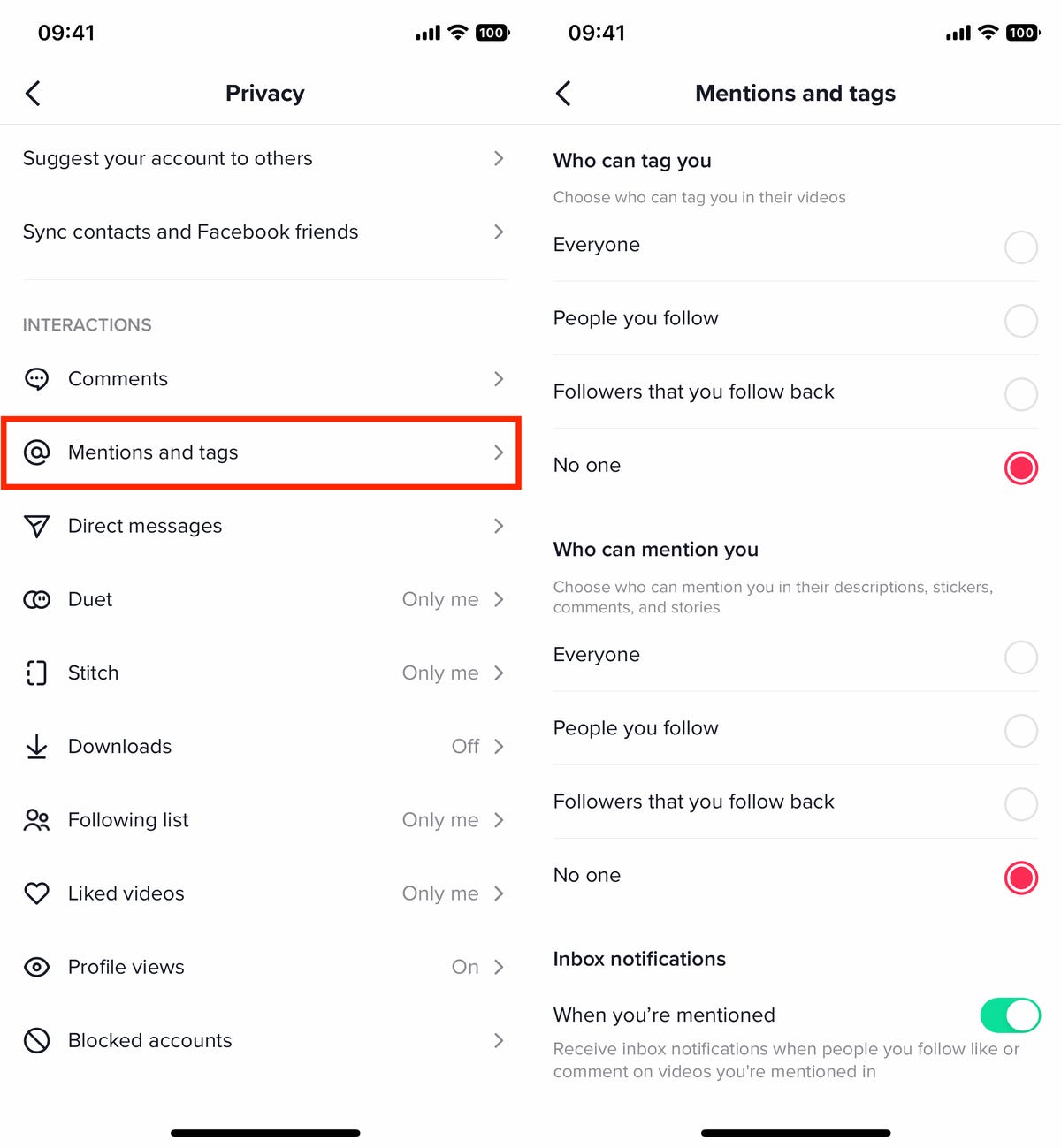

You can restrict who mentions and tags you on TikTok
Nelson Aguilar/CNETAn in-box notification setting can also send you a notification anytime someone you follow likes or comments on videos you’re mentioned in, but that doesn’t really affect your privacy on TikTok.
Stop direct messages from strangers and stalkers on TikTok
While most content on TikTok is out there for the world to see, direct messages aren’t so clear and visible. Many people use DMs to harass, bully and spam other people. However, there is a way to help prevent that from happening to you.
Go to Profile > three-dash menu > Settings and privacy > Privacy > Direct messages, and change these settings:
- Who can send you direct messages: Choose between Followers that follow you back, People you sent messages to or No one.
- Message preference: If you toggle Filtered requests on, messages from people that TikTok suspects as being malicious or spammy will appear in your filtered requests until you reply to them.
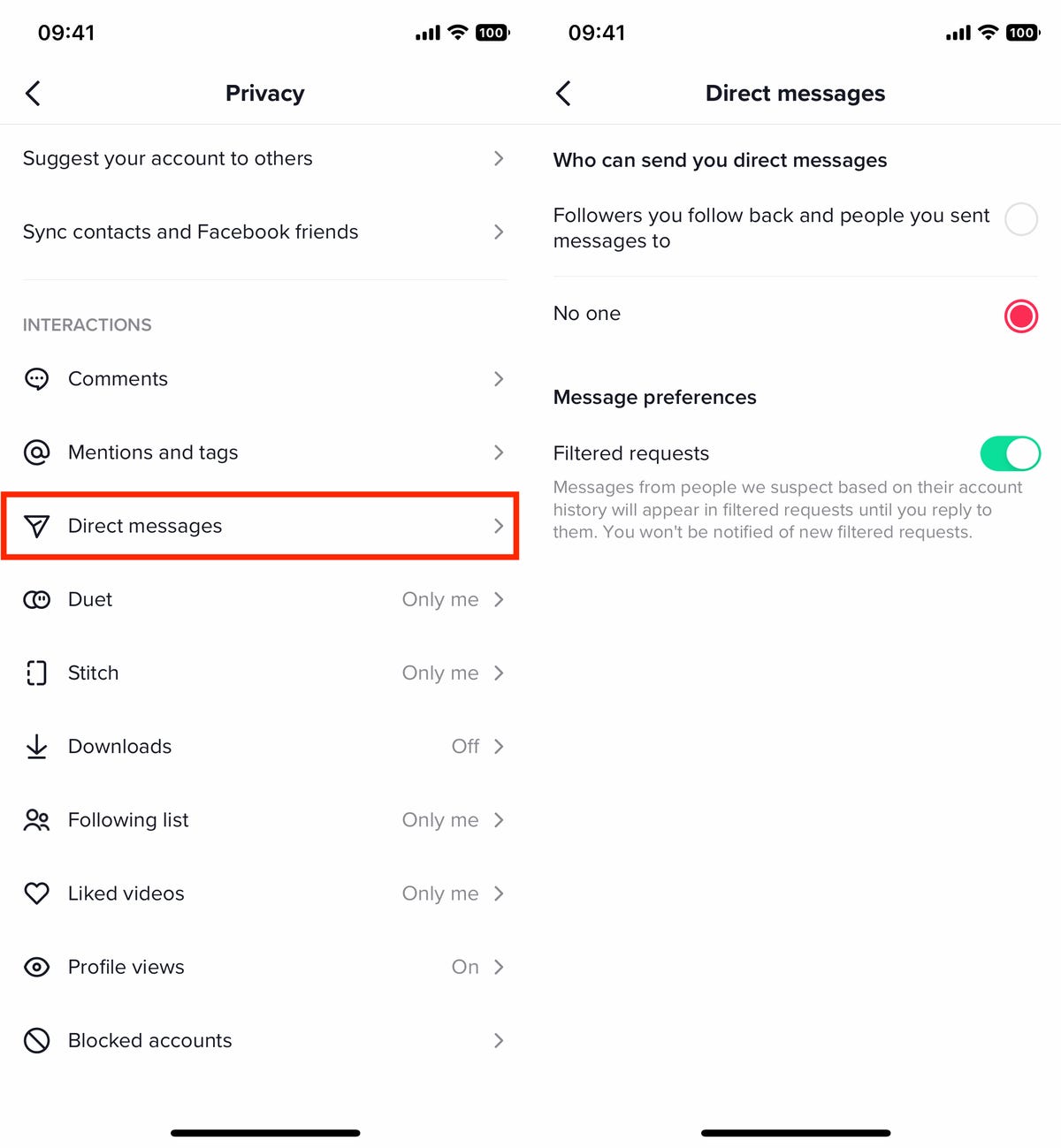

Don’t let just anyone send you a direct message.
Nelson AguilarRestrict who can Duet or Stitch your TikTok videos
On TikTok, you can react to other videos by either inserting yourself into their videos or using their videos in your own. The Duet feature lets you create a reaction split-screen video, combining half of your video with half of someone’s else’s video to create a single reaction video. With the Stitch feature, your video and someone else’s video are integrated into each other — you can edit a portion of their video into yours.
If you’re not a fan of these features or don’t want other users putting your videos into theirs, you can disable them so that no one can Duet or Stitch your video. To do this, go to Profile > three-dash menu > Settings and privacy > Privacy and then:
- Duet: Choose between Followers, Followers that follow back or No one.
- Stitch: Choose between Followers, Followers that follow back or No one.
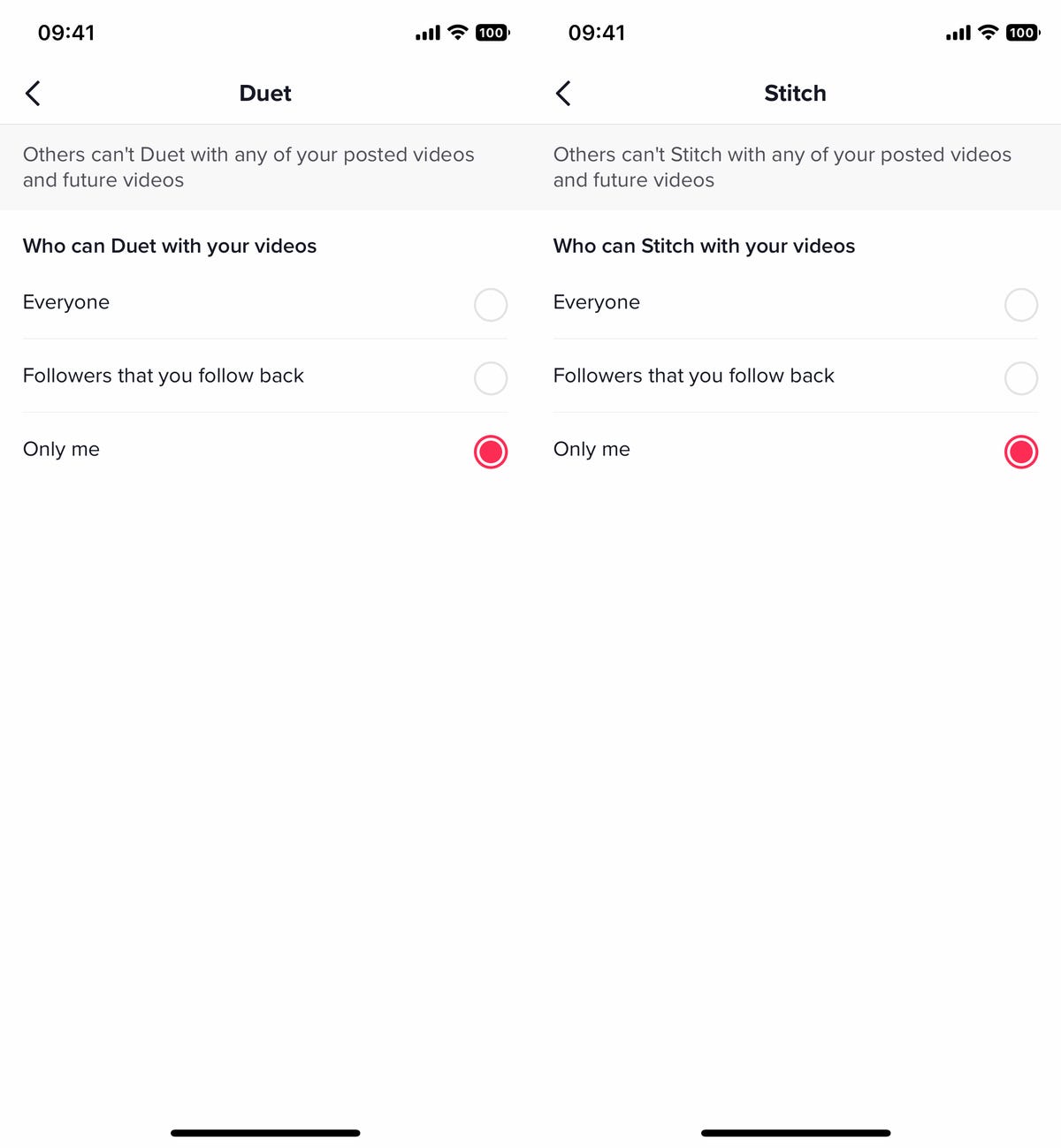

The Duet and Stitch features are fun, but they can also get out of control.
Nelson Aguilar/CNETIf your account is set to private, no one but you can create a Duet or Stitch with your videos.
Prevent others from viewing your following list and liked videos
You might post videos on TikTok for everyone to see, but that doesn’t necessarily mean you want everyone to be able to see who you’re following or which videos you like. Who you follow and what you like can give others more information than you might want to share, but you can easily set TikTok so that no one but you can see your follower list and liked videos.
To stop others from viewing your following list or liked videos, go go to Profile > three-dash menu > Settings and privacy > Privacy and then:
- Following list: Choose between Followers or Only me.
- Liked videos: Choose between Followers or Only me.
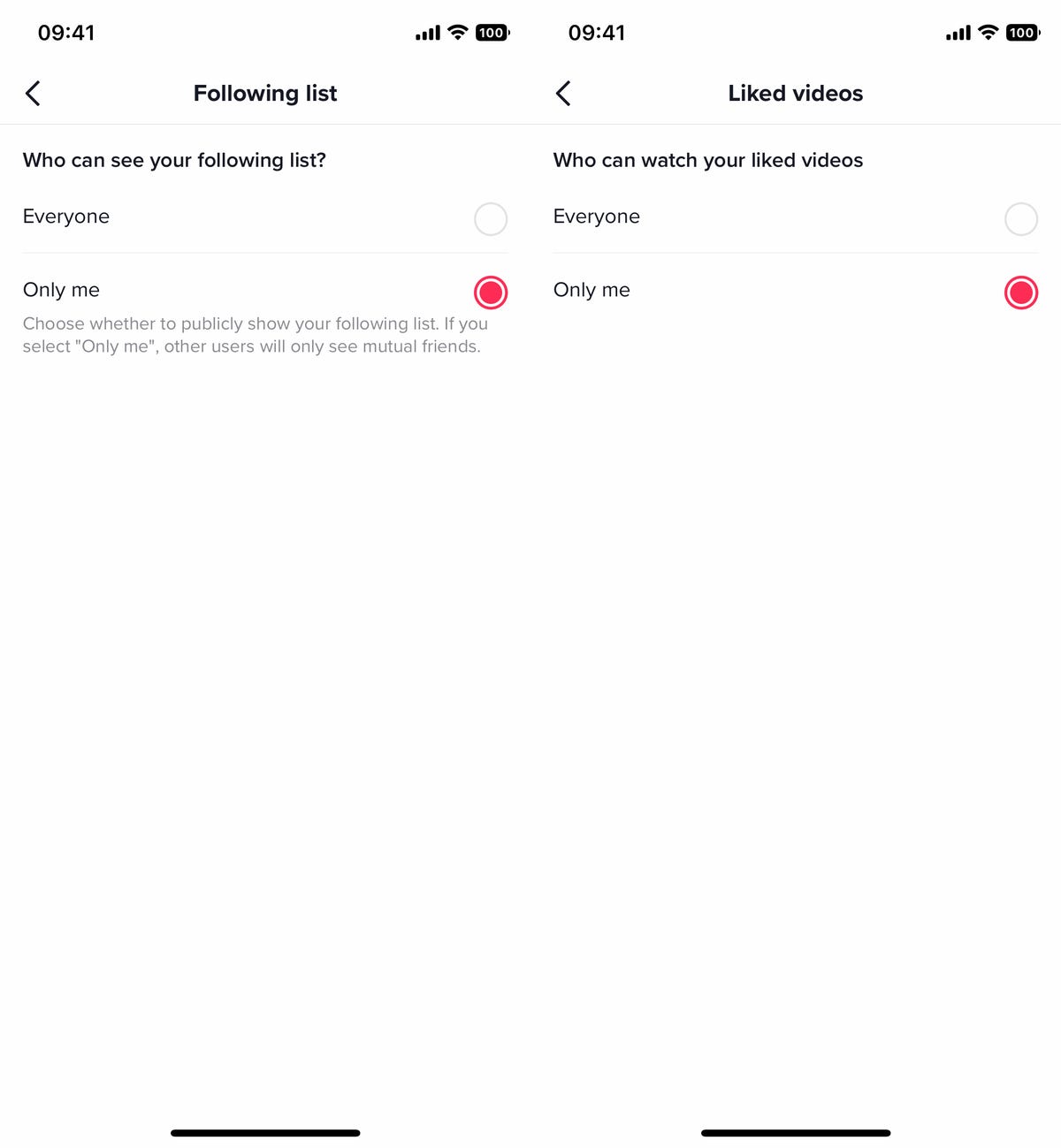

Just because you follow accounts and like videos doesn’t mean the whole world needs to know it.
Nelson Aguilar/CNETIf you select the «only me» option for the following list, other users will still be able to see your mutual friends.
For more about TikTok and privacy, learn how the company is protecting young users from inappropriate videos and why some US regulators are worried about TikTok sharing private user data with China.
Technologies
How to Add These Hidden Music and Apple Intelligence Controls to Your iPhone
One control can Apple’s Visual Intelligence to more devices besides the iPhone 16 lineup.
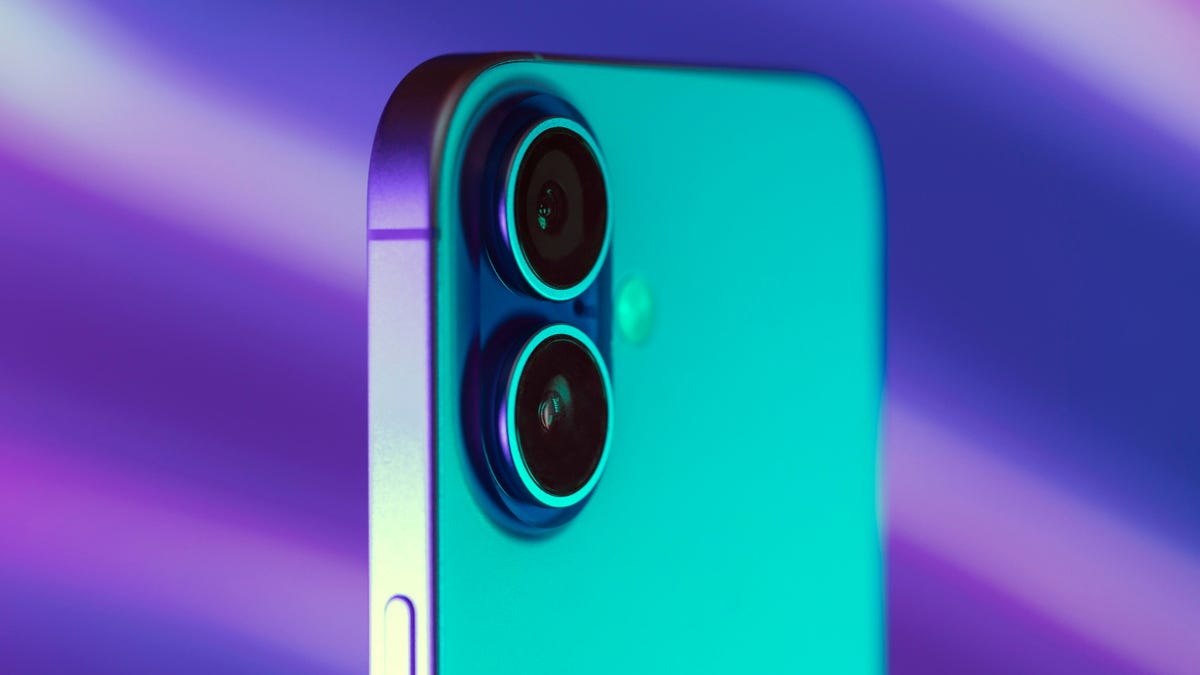
Apple released iOS 18.4 on March 31, and the update brought bug fixes, new emoji and a new recipes section in Apple News to all iPhones. The update also brought a handful of new controls to the iPhone Control Center, including one that brings Visual Intelligence to the iPhone 15 Pro and iPhone 15 Pro Max.
When Apple released iOS 18 in September, the update remodeled the Control Center to give you more control over how the feature functions. With iOS 18, you can resize controls, assign some controls to their own dedicated page and adjust the placement of controls to your liking. Apple also introduced more controls to the feature, making it a central hub for all your most-used iPhone features.
Read more: Everything You Need to Know About iOS 18
With iOS 18.4, Apple continues to expand the number of controls you can add to the Control Center. If you have the update on your iPhone, you can add ambient music controls, and Apple Intelligence-enabled iPhones get a few AI controls in the menu, too. Here’s what you need to know about the new controls and how to add them to your Control Center.
Ambient Music controls
Apple gave everyone four new controls in the Control Center library under the Ambient Music category. These controls are Sleep, Chill, Productivity and Wellbeing. Each of these controls can activate a playlist filled with music that corresponds to the specific control. Sleep, for instance, plays ambient music to help lull you to bed.
Some studies suggest white noise could help adults learn words and improve learning in environments full of distractions. According to the mental health company Calm, certain kinds of music can help you fall asleep faster and improve the quality of your sleep. So these new controls can help you learn, fall asleep and more.
Here’s how to find these controls.
1. Swipe down from the top-right corner of your Home Screen to open your Control Center.
2. Tap the plus (+) sign in the top-left corner of your screen.
3. Tap Add a Control.
You’ll see a section of controls called Ambient Music. You can also search for «Ambient Music» in the search bar at the top of the control library. Under Ambient Music, you’ll see all four controls. Tap one (or all) of them to add them to your Control Center. Once you’ve added one or all the controls to your Control Center, go back to your Control Center and tap one to start playing music.
Here’s how to change the playlist for each control.
1. Swipe down from the top-right corner of your Home Screen to open your Control Center.
2. Tap the plus (+) sign in the top-left corner of your screen.
3. Tap the Ambient Music control you want to edit.
4. Tap the playlist to the right of Playlist.
A dropdown menu will appear with additional playlists for each control. If you’re in the Sleep control, you’ll see playlists like Restful Notes and Lo-Fi Snooze. If you have playlists in your Music app, then you’ll also see an option From Library, which pulls music from your library. Tap whichever playlist you want and it will be assigned to that control.
Apple already lets you transform your iPhone into a white noise machine with Background Sounds, like ocean and rain. But Ambient Music is actual music as opposed to more static sounds like in that feature.
Both of these features feel like a way for Apple to present itself as the first option for whenever you want some background music to help you fall asleep or be productive. Other services, like Spotify and YouTube, already have ambient music playlists like these, so this could be Apple’s way of taking some of those service’s audience.
Apple Intelligence controls
Only people with an iPhone 15 Pro, iPhone 15 Pro Max or the iPhone 16 lineup can access Apple Intelligence features for now, and those people got three new dedicated Apple Intelligence controls with iOS 18.4. Those controls are Talk to Siri, Type to Siri and Visual Intelligence.
Here’s how to find these controls.
1. Swipe down from the top-right corner of your Home Screen to open your Control Center.
2. Tap the plus (+) sign in the top-left corner of your screen.
3. Tap Add a Control.
Then you can use the search bar near the top of the screen to search for «Apple Intelligence» or you can scroll through the menu to find the Apple Intelligence & Siri section. Tap any (or all) of these controls to add them to your Control Center. While Talk to Siri and Type to Siri controls can be helpful if you have trouble accessing the digital assistant, the Visual Intelligence control is important because it brings the Apple Intelligence feature to the iPhone 15 Pro and Pro Max.
Visual Intelligence was originally only accessible on the iPhone 16 lineup because those devices have the Camera Control button. With iOS 18.4, Visual Intelligence is now accessible on more devices and people thanks to the titular control in Control Center. But remember, Visual Intelligence is like any other AI tool so it won’t always be accurate. You should double check results and important information it shows you.
For more on iOS 18, here are all the new emoji you can use now and everything you should to know about the recipes section in Apple News. You can also check out all the features included in iOS 18.5 and our iOS 18 cheat sheet.
Technologies
Tariffs Explained: How Trump’s Ever-Changing Trade Policy Will Affect You
While Donald Trump’s wide-ranging taxes on imports face scrutiny in court, he also continues to alter them and introduce or propose others. Here’s what it will mean for you.
President Donald Trump’s second-term economic plan can be summed up in one word: tariffs. When his barrage of import taxes went into overdrive a month ago, markets trembled and business leaders sounded alarms about the economic damage they would cause. After weeks of uncertainty and clashes with major companies, Trump’s tariffs hit their biggest roadblock yet in court before being reinstated ahead of a final ruling, allowing him to double the rate on imported steel and aluminum this week.
Late Wednesday, the US Court of International Trade ruled that Trump had overstepped his authority when he imposed tariffs, effectively nullifying the tariffs, after concluding that Congress has the sole authority to issue tariffs and decide other foreign trade matters, and that the International Emergency Economic Powers Act of 1977 — which Trump has used to justify his ability to impose them — doesn’t grant the president «unlimited» authority on tariffs. The next day, an appeals court allowed the tariffs to go back into effect for the time being, while the administration calls for the Supreme Court to overturn the trade court ruling altogether.
However things shake out in the end, the initial ruling certainly came as a relief to many, given the chaos and uncertainty that Trump’s tariffs how caused thus far. For his part, Trump has recently lashed out against companies — like Apple and Walmart — that have reacted to the tariffs or discussed their impacts in ways he dislikes. Apple has been working to move manufacturing for the US market from China to relatively less-tariffed India, to which Trump has threatened them with a 25% penalty rate if they don’t bring manufacturing to the US instead. Experts have predicted that a US-made iPhone, for example, would cost consumers about $3,500. During a recent earnings call, Walmart warned that prices would rise on things like toys, tech and food at some point in the summer, which prompted Trump to demand the chain eat the costs themselves, another unlikely scenario.
Amid all this noise, you might still be wondering: What exactly are tariffs and what will they mean for me?
The short answer: Expect to pay more for at least some goods and services. For the long answer, keep reading, and for more, check out CNET’s price tracker for 11 popular and tariff-vulnerable products.
What are tariffs?
Put simply, a tariff is a tax on the cost of importing or exporting goods by a particular country. So, for example, a «60% tariff» on Chinese imports would be a 60% tax on the price of importing, say, computer components from China.
Trump has been fixated on imports as the centerpiece of his economic plans, often claiming that the money collected from taxes on imported goods would help finance other parts of his agenda. The US imports $3 trillion of goods from other countries annually.
The president has also, more recently, shown a particular fixation on trade deficits, claiming that the US having a trade deficit with any country means that country is ripping the US off. This is a flawed understanding of the matter, as a lot of economists have said, deficits are often a simple case of resource realities: Wealthy nations like the US buy specific things from nations that have them, while those nations might in turn not be wealthy enough to buy much of anything from the US.
While Trump deployed tariffs in his first term, notably against China, he ramped up his plans more significantly for the 2024 campaign, promising 60% tariffs against China and a universal 20% tariff on all imports into the US. Now, tariffs against China are more than double that amount and a universal tariff on all exports is a reality.
«Tariffs are the greatest thing ever invented,» Trump said at a campaign stop in Michigan last year. At one point, he called himself «Tariff Man» in a post on Truth Social.
Who pays the cost of tariffs?
Trump repeatedly claimed, before and immediately after returning to the White House, that the country of origin for an imported good pays the cost of the tariffs and that Americans would not see any price increases from them. However, as economists and fact-checkers stressed, this is not the case.
The companies importing the tariffed goods — American companies or organizations in this case — pay the higher costs. To compensate, companies can raise their prices or absorb the additional costs themselves.
So, who ends up paying the price for tariffs? In the end, usually you, the consumer. For instance, a universal tariff on goods from Canada would increase Canadian lumber prices, which would have the knock-on effect of making construction and home renovations more expensive for US consumers. While it is possible for a company to absorb the costs of tariffs without increasing prices, this is not at all likely, at least for now.
Speaking with CNET, Ryan Reith, vice president of International Data’s worldwide mobile device tracking programs, explained that price hikes from tariffs, especially on technology and hardware, are inevitable in the short term. He estimated that the full amount imposed on imports by Trump’s tariffs would be passed on to consumers, which he called the «cost pass-through.» Any potential efforts for companies to absorb the new costs themselves would come in the future, once they have a better understanding of the tariffs, if at all.
Which Trump tariffs have gone into effect?
Following Trump’s «Liberation Day» announcements on April 2, the following tariffs are in effect:
- A 50% tariff on all steel and aluminum imports, doubled from 25% as of June 4.
- A 30% tariff on all Chinese imports until Aug. 10 while negotiations continue. China being a major focus of Trump’s trade agenda, this rate has been notably higher than others and has steadily increased as Beijing returned fire with tariffs of its own, peaking at 145%, which it could return to down the line if a deal is not reached.
- 25% tariffs on imports from Canada and Mexico not covered under the 2018 USMCA trade agreement brokered during Trump’s first term. The deal covers roughly half of all imports from Canada and about a third of those from Mexico, so the rest are subject to the new tariffs. Energy imports not covered by USMCA only will be taxed at 10%.
- A 25% tariff on all foreign-made cars and auto parts.
- A sweeping overall 10% tariff on all imported goods.
For certain countries that Trump said were more responsible for the US trade deficit, Trump imposed what he called «reciprocal» tariffs that exceed the 10% level: 20% for the 27 nations that make up the European Union, 26% for India, 24% for Japan and so on. These were meant to take effect on April 9 but were delayed by 90 days as a result of historic stock market volatility, which makes the new effective date July 8.
— Rapid Response 47 (@RapidResponse47) April 2, 2025
Trump’s claim that these reciprocal tariffs are based on high tariffs imposed against the US by the targeted countries has drawn intense pushback from experts and economists, who have argued that some of these numbers are false or potentially inflated. For example, the above chart claims a 39% tariff from the EU, despite its average tariff for US goods being around 3%. Some of the tariffs are against places that are not countries but tiny territories of other nations. The Heard and McDonald Islands, for example, are uninhabited. We’ll dig into the confusion around these calculations below.
Notably, that minimum 10% tariff will not be on top of those steel, aluminum and auto tariffs. Canada and Mexico were also spared from the 10% minimum additional tariff imposed on all countries the US trades with.
On April 11, the administration said smartphones, laptops and other consumer electronics, along with flat panel displays, memory chips and semiconductors, were exempt from reciprocal tariffs. But it wasn’t clear whether that would remain the case or whether such products might face different fees later.
How were the Trump reciprocal tariffs calculated?
The numbers released by the Trump administration for its barrage of «reciprocal» tariffs led to widespread confusion among experts. Trump’s own claim that these new rates were derived by halving the tariffs already imposed against the US by certain countries was widely disputed, with critics noting that some of the numbers listed for certain countries were much higher than the actual rates and some countries had tariff rates listed despite not specifically having tariffs against the US at all.
In a post to X that spread fast across social media, finance journalist James Surowiecki said that the new reciprocal rates appeared to have been reached by taking the trade deficit the US has with each country and dividing it by the amount the country exports to the US. This, he explained, consistently produced the reciprocal tariff percentages revealed by the White House across the board.
Just figured out where these fake tariff rates come from. They didn’t actually calculate tariff rates + non-tariff barriers, as they say they did. Instead, for every country, they just took our trade deficit with that country and divided it by the country’s exports to us.
So we… https://t.co/PBjF8xmcuv— James Surowiecki (@JamesSurowiecki) April 2, 2025
«What extraordinary nonsense this is,» Surowiecki wrote about the finding.
The White House later attempted to debunk this idea, releasing what it claimed was the real formula, though it was quickly determined that this formula was arguably just a more complex version of the one Surowiecki deduced.
What will the Trump tariffs do to prices?
In short: Prices are almost certainly going up, if not now, then eventually. That is, if the products even make it to US shelves at all, as some tariffs will simply be too high for companies to bother dealing with.
While the effects of a lot of tariffs might not be felt straight away, some potential real-world examples have already emerged. Microsoft has increased prices across the board for its Xbox gaming brand, with its flagship Xbox Series X console jumping 20% from $500 to $600. Elsewhere, Kent International, one of the main suppliers of bicycles to Walmart, announced that it would be stopping imports from China, which account for 90% of its stock.
Speaking about Trump’s tariff plans just before they were announced, White House trade adviser Peter Navarro said that they would generate $6 trillion in revenue over the next decade. Given that tariffs are most often paid by consumers, CNN characterized this as potentially «the largest tax hike in US history.» New estimates from the Yale Budget Lab, cited by Axios, predict that Trump’s new tariffs will cause a 2.3% increase in inflation throughout 2025. This translates to about a $3,800 increase in expenses for the average American household.
Reith, the IDC analyst, told CNET that Chinese-based tech companies, like PC makers Acer, Asus and Lenovo, have «100% exposure» to these import taxes as they currently stand, with products like phones and computers the most likely to take a hit. He also said that the companies best positioned to weather the tariff impacts are those that have moved some of their operations out of China to places like India, Thailand and Vietnam, singling out the likes of Apple, Dell and HP. Samsung, based in South Korea, is also likely to avoid the full force of Trump’s tariffs.
In an effort to minimize its tariff vulnerability, Apple has begun to move the production of goods for the US market from China to India.
Will tariffs impact prices immediately?
In the short term — the first days or weeks after a tariff takes effect — maybe not. There are still a lot of products in the US imported pre-tariffs and on store shelves, meaning the businesses don’t need a price hike to recoup import taxes. Once new products need to be brought in from overseas, that’s when you’ll see prices start to climb because of tariffs or you’ll see them become unavailable.
That uncertainty has made consumers anxious. CNET’s survey revealed that about 38% of shoppers feel pressured to make certain purchases before tariffs make them more expensive. About 10% say they have already made certain purchases in hopes of getting them in before the price hikes, while 27% said they have delayed purchases for products that cost more than $500. Generally, this worry is the most acute concerning smartphones, laptops and home appliances.
Mark Cuban, the billionaire businessman and Trump critic, voiced concerns about when to buy certain things in a post on Bluesky just after Trump’s «Liberation Day» announcements. In it, he suggested that consumers might want to stock up on certain items before tariff inflation hits.
«It’s not a bad idea to go to the local Walmart or big box retailer and buy lots of consumables now,» Cuban wrote. «From toothpaste to soap, anything you can find storage space for, buy before they have to replenish inventory. Even if it’s made in the USA, they will jack up the price and blame it on tariffs.»
CNET’s Money team recommends that before you make any purchase, especially of a high-ticket item, be sure that the expenditure fits within your budget and your spending plans in the first place. Buying something you can’t afford now because it might be less affordable later can be burdensome, to say the least.
What is the goal of the White House tariff plan?
The typical goal behind tariffs is to discourage consumers and businesses from buying the tariffed, foreign-sourced goods and encourage them to buy domestically produced goods instead. When implemented in the right way, tariffs are generally seen as a useful way to protect domestic industries.
One of the stated intentions for Trump’s tariffs is along those lines: to restore American manufacturing and production. However, the White House also claims to be having negotiations with numerous countries looking for tariffs exemptions and some officials have also floated the idea that the tariffs will help finance Trump’s tax cuts.
You don’t have to think about those goals for too long before you realize that they’re contradictory: If manufacturing moves to the US or if a bunch of countries are exempt from tariffs then tariffs aren’t actually being collected and can’t be used to finance anything. This and many other points have led a lot of economists to allege that Trump’s plans are misguided.
In terms of returning — or «reshoring» — manufacturing in the US, tariffs are a better tool for protecting industries that already exist because importers can fall back on them right away. Building up the factories and plants needed for this in the US could take years, leaving Americans to suffer under higher prices in the interim.
That problem is worsened by the fact that the materials needed to build those factories will also be tariffed, making the costs of «reshoring» production in the US too heavy for companies to stomach. These issues, and the general instability of American economic policies under Trump, are part of why experts warn that Trump’s tariffs could have the opposite effect: keeping manufacturing out of the US and leaving consumers stuck with inflated prices. Any factories that do get built in the US because of tariffs also have a high chance of being automated, canceling out a lot of job creation potential. To give you one real-world example of this: When warning customers of future price hikes, toy maker Mattel also noted that it had no plans to move manufacturing to the US.
Trump has reportedly been fixated on the notion that Apple’s iPhone — the most popular smartphone in the US market — can be manufactured entirely in the US. This has been broadly dismissed by experts, for a lot of the same reasons mentioned above, but also because an American-made iPhone could cost upward of $3,500. One report from 404 Media dubbed the idea «a pure fantasy.» The overall sophistication and breadth of China’s manufacturing sector has also been cited, with CEO Tim Cook stating in 2017 that the US lacks the number of tooling engineers to make its products.
For more, see how tariffs might raise the prices of Apple products and find some expert tips for saving money.
Technologies
Today’s NYT Mini Crossword Answers for Sunday, June 8
Here are the answers for The New York Times Mini Crossword for June 8.
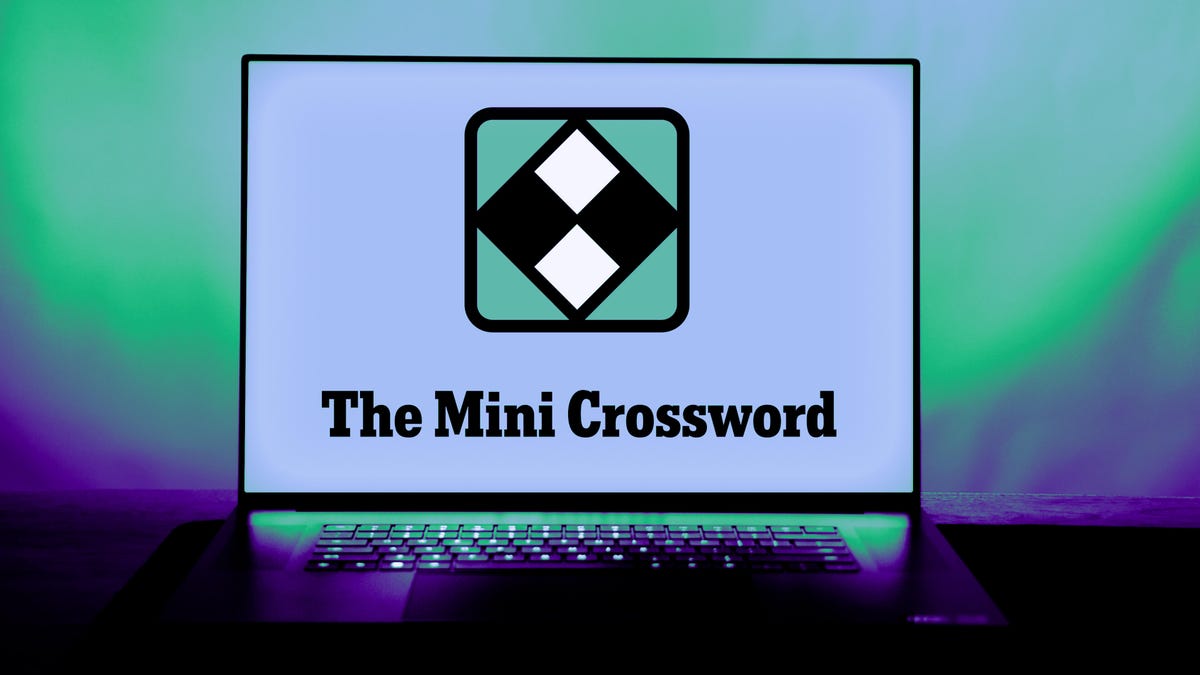
Looking for the most recent Mini Crossword answer? Click here for today’s Mini Crossword hints, as well as our daily answers and hints for The New York Times Wordle, Strands, Connections and Connections: Sports Edition puzzles.
Today’s NYT Mini Crossword isn’t too tough, but 1-Across might make you think of the sky, and that’s not the direction you need to go. Need some help with today’s Mini Crossword? Read on. And if you could use some hints and guidance for daily solving, check out our Mini Crossword tips.
The Mini Crossword is just one of many games in the Times’ games collection. If you’re looking for today’s Wordle, Connections, Connections: Sports Edition and Strands answers, you can visit CNET’s NYT puzzle hints page.
Read more: Tips and Tricks for Solving The New York Times Mini Crossword
Let’s get to those Mini Crossword clues and answers.
Mini across clues and answers
1A clue: Org. with shooting stars
Answer: NBA
4A clue: Buildings with weather vanes, stereotypically
Answer: BARNS
6A clue: Swiss watch brand
Answer: OMEGA
7A clue: What Santa, Gandalf and Dumbledore each have
Answer: BEARD
8A clue: Pie in the ___
Answer: SKY
Mini down clues and answers
1D clue: «I’m bad with ___» (party excuse)
Answer: NAMES
2D clue: Start of a billiards game
Answer: BREAK
3D clue: Seeing red
Answer: ANGRY
4D clue: Timothée’s role in «A Complete Unknown»
Answer: BOB
5D clue: Feeling blue
Answer: SAD
How to play more Mini Crosswords
The New York Times Games section offers a large number of online games, but only some of them are free for all to play. You can play the current day’s Mini Crossword for free, but you’ll need a subscription to the Times Games section to play older puzzles from the archives.
-

 Technologies2 года ago
Technologies2 года agoTech Companies Need to Be Held Accountable for Security, Experts Say
-

 Technologies2 года ago
Technologies2 года agoBest Handheld Game Console in 2023
-

 Technologies2 года ago
Technologies2 года agoTighten Up Your VR Game With the Best Head Straps for Quest 2
-

 Technologies4 года ago
Technologies4 года agoVerum, Wickr and Threema: next generation secured messengers
-

 Technologies4 года ago
Technologies4 года agoGoogle to require vaccinations as Silicon Valley rethinks return-to-office policies
-

 Technologies4 года ago
Technologies4 года agoBlack Friday 2021: The best deals on TVs, headphones, kitchenware, and more
-

 Technologies4 года ago
Technologies4 года agoOlivia Harlan Dekker for Verum Messenger
-

 Technologies4 года ago
Technologies4 года agoiPhone 13 event: How to watch Apple’s big announcement tomorrow
